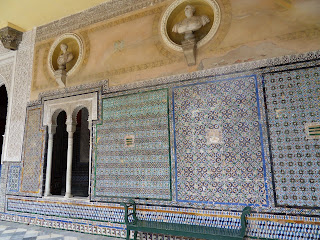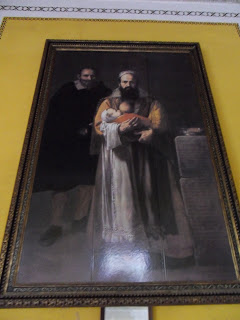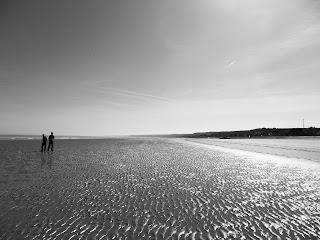Thursday night of 2 weeks ago, during my stay in London, I went to Normandy, which is the northern region of Spain facing the Channel. I knew the travel there would be stressful since it included a metro, train, overnight ferry, and two buses to reach my destination, but I was feeling up to the challenge. Getting off the train at Portsmouth Harbor in the south of England, I was a little unnerved by the lack of people and it turned out that I was at the wrong station, and had a little walking to do.

Nonetheless, I made it to the ferry station and got on my boat. I didn't take any pictures but these "ferries" are basically small cruise ships, with a theatre, multiple restaurants, a dance club, and various lounges. Nonetheless I just found a seat, reclined as far back as I could, threw a shirt over my eyes, and fell fast asleep. I woke up at 5:45 in perfect time to get off the boat and grab a bus to Caen, which is a small city in northern France which is the heart of all the war memorials. I was excited to be back in France but the early morning drowsiness combined with the heavy fog that was literally everywhere combined to put me into a cold, soggy, zombie like state that required 3 cups of coffee.
Then I grabbed another bus which took me to the Normandy World War II Memorial. (More fog)
Outside the entrance there were stone blocks from each country involved with the Allied cause, and each with a certain saying upon them.
So we've got America with a classic quote from Ike:
France, with a typically airy and poetic call: (Translation=I was born to know thee, to call thee Liberty)
And then we've got Greece: "We prefer peace to war." Eloquent.
I literally had no idea how to see Normandy before I talked with a woman in the tourist office at the France ferry harbor, but it seemed that the best option was a 4 hour guided tour. Our tour guide turned out to be awesome and we saw a lot of major major sites during the war.
The first thing we saw was an artificial harbor called a "mulberry" that Churchill drug over from Britain to serve as a supplies harbor to the town of Arromanche. (I should note that Normandy is a province of northern France encompassing all these towns). Since Hitler fortified all the harbors in France so well, Churchill decided if they couldn't take a harbor, they'd bring one. Unfortunately there were only two constructed and within the first 2 weeks of operation a storm badly battered them. The other mulberry off Omaha beach was destroyed beyond repair, and this one required 2 months to repair.

A more efficient supplies strategy came from the Americans, who just bull-rushed everything over in ships.
Picture of Sword Beach, the eastern-most of the five landing zones, and taken by the Brits.
Climbing up these cliffs proved to be the most deadly part of the invasion.
And here's a German cannon bunker. Untouched by the bombing, it remains exactly as it was during the war.
After Arromanche, we went to the American cemetary and memorial, which was in a very somber and powerful way the highlight of my trip. We started out in the Garden of the Lost, with every one of the 1,557 Americans whose bodies have never been found.
Inside, there was this map of the overall plan for "Operation Overlord", which most people would agree saved nearly the entire world from Hitler. Plans of Hitler have been found to invade very nearly the entire world, so it's hard to understate the importance of June 6, 1944 for everyone worldwide.
Reflecting pool:
The actual cemetery is staggering. It's hard to grasp 9,387 graves, and furthermore that there were around 20,000 Americans who died in the invasion of France that are buried in the States. The exact totals from D-Day and the invasion of Normandy in total are incredibly unreliable, and to this day in this rural part of France, farmers will occasionally plow up a body from the war, sometimes with I.D. But generally it looks like around 3000-4000 men died during the morning and afternoon hours, and just on Omaha Beach. Casualties there were so high that they were a little easier to calculate. What I didn't realize was that securing the beaches didn't constitute any sort of victory. Allied forces continued to fight for months to push the Germans out of France. Normandy was just the beginning.
Pardon the drama, but for me, the most powerful thing was to look at the names. When there are so many of something, you forget the importance of each. Each one of these gravestones has a name and a story, family, job, and everything else, that ended in France, literally saving the world.
View of Omaha Beach from the cemetery:
After the cemetery, we drove down to the actual Omaha Beach. The thing about it is that it's just a beach now; people have houses there. As our guide pointed out, the beach didn't choose it's role. None of the Belgian doors or hedgehogs are there anymore, but it's still arguably the most famous, and important site of World War II.
For me, going down to the water where this famous photo was taken...
...was the most moving part of the beaches. Looking back at the vast (and Omaha Beach is about 100 yards deep) beach and the imposing bluffs behind it gave me the chills. I've seen Saving Private Ryan but to touch the water and the sand that so many men died on was very moving. In a very strange way, being on Omaha Beach made me question myself in ways that normal life never does. I couldn't help but wonder if I would've had the courage to storm these beaches. Would I have the strength to watch friends die and keep moving forward? And then if I did reach the base of the bluffs, would I have the fortitude to climb and push forward instead of staying below in relative safety. I hope I never have to know these questions but it was scary to think about the fact that I'm 21, and many many men that lived and died on this beach were my age or younger.

Many of the German foxholes are gone now but some still remain. Spooky:
After the beaches we drove up to Pont Du-Hoc, where 7 German cannons used to be positioned. The Allies knew about the location and decided it was crucial to disable the cannons which each had range to fire up to 25,000 yards. Around 140 of 220 men died climbing (literally they had to climb) the cliffs, and when the Army Rangers 2nd Battalion got there, they realized the cannons had been moved back to safer locations because the Germans didn't want to lose them in the inevitable air raids. Those air raids left giant craters in the ground that are still a sight today. Sadly, the battalion lost over 140 of 225 men.
German fort:
Another German fort:
Bigger view:
After the tour, I had lunch, and then went into the museum back near Caen. The picture archives took me through the entire process of Overlord, from the planning to the conception, to the march to Berlin.
Here are a few of the best pictures:
The landing:

Allied soldiers at leave and playing baseball in Normandy:

The thick hedges used to separate cattle made the task of reclaiming France a brutal one. Here you can kind of see the hedges on both sides. And also, this is one of those pictures that makes me realize how brave these men really were:
French gratitude:
At the end of the photo archives I had taken over 300 pictures that day so I put the camera away for a little while. I watched a couple movies on D-Day in the museum theatre, and then wandered through the new cold war exhibit they had which made me realize how little I understand about the state of the world 50 years ago and on.
After a very packed day in every sense of the word, I took a bus back to downtown Caen, which was much more lively without any fog.
And as it goes with every part of Europe, there's a lot of old stuff. As in, older than America. This is an old castle that is right in the middle of Caen. Despite its grandeur, the inhabitants seemed to have no idea what it was or how old it was. But one man told me it used to be a private castle and it's around 500 years old.
And as if I need to see another old church, here's just your standard gothic-style European church. Remember, this is in Caen, France. There's nothing that makes Caen very special other than the war memorials, so you can try and think about how many incredible, old churches there really are in Europe.
I was exhausted after the day, but in my usual manner, managed to miss my bus stop, and would've continued happily riding along had we not gotten to the bus depot, where I clearly had to get off. When I asked the bus driver where to go and that I had a ferry to catch, he told me to keep walking straight. The directions were spot on, but after stopping into a couple hotels (there are much fewer english speakers in Caen than in Paris), I finally could piece things together that I was on the right street, but very far away from the ferry port.
I didn't really have any options so I just strolled along through a quaint little French town. I've gotta tell you I continue to be shown that France is just a great place to live. Really everything is attractive and clean and the people are very friendly. Nonetheless, walking through a French town by moonlight, not knowing how far you've gotta go or remotely where you are on a map, isn't as much fun after a half-hour or so. And after 45 minutes I was about ready to just give up on the ferry and wait to be kicked out of France. But luckily I kept walking and then in an act of divine Providence, a man drove past the other way, stopped, and asked me if I was headed to the ferries. Sounds like the "last voice he heard" type story, but like I said, I was feeling pretty desperate. He ended up knowing a little english and I was able to decipher that I had at least an hour of walking ahead of me. Instead, he turned around and drove me right up to my gate.

I was very relieved to be on a boat headed to London, and I probably feel asleep within 10 minutes on the ferry. All in all, the travel it took to get me to Caen and back to London was terrible. However, the war memorials and things I saw in Normandy I will remember forever, and I hope other people will remember the many men of June 6 as well.
















































































